Religion in Brazil

| Religion by country |
|---|
|
|
| Part of a series on the |
| Culture of Brazil |
|---|
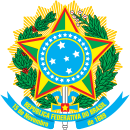 |
| Society |
| Topics |
|
| Symbols |
|
|

Christianity is the largest religion in Brazil, with Catholics having the most adherents. Brazil possesses a richly spiritual society formed from the meeting of the Catholic Church with the religious traditions of enslaved Africans and indigenous people. This confluence of faiths during the Portuguese colonization of Brazil led to the development of a diverse array of syncretistic practices within the overarching umbrella of Brazilian Catholicism, characterized by traditional Portuguese festivities.[4] Until recently Catholicism was overwhelmingly dominant. Rapid change in the 21st century has led to a growth in secularism (no religious affiliation), and Evangelical Protestantism to over 22% of the population. The 2010 census indicates that under 65% of Brazilians consider themselves Catholic, down from 90% in 1970, leading Cardinal Cláudio Hummes to comment, "We wonder with anxiety: how long will Brazil remain a Catholic country?."[5][6] despite falling in most of the country, Catholicism remains strong in most of the Northeast.[7][8]
In 1891, when the first Brazilian Republican Constitution was set forth, Brazil ceased to have an official religion and has remained secular ever since, though the Catholic Church remained politically influential into the 1970s. The Constitution of Brazil guarantees freedom of religion and strongly prohibits the establishment of any religion by banning government support or hindrance of religion at all levels.[4] In the 2010 census[1] 64.63% of the population declared themselves as Catholic, 22.2% as Protestant, 8% as non religious, and 5.2% as followers of other religions (mostly Spiritists or Kardecists who follow the doctrines of Allan Kardec, Umbandists, Candomblers, Jehovah's Witnesses, Mormons, and minorities of Buddhists, Jews, Muslims, and other groups).
Brazilian religions are very diversified and inclined to syncretism. In recent decades, there has been a great increase of Neo-Pentecostal churches and a thriving of Afro-Brazilian religions,[9] which have decreased the number of members of the Roman Catholic Church.[10] The number of Umbandists and Candomblers could be significantly higher than the official census figure, since many of them continue to this day to disguise their religion under "Catholic" syncretism.[11] About ninety percent of Brazilians declared some sort of religious affiliation in the most recent census.[12]
Although the Federal Constitution guarantees religious tolerance to all its citizens (see article 5, item VI), it expressly prohibits all entities that make up the Federation to found and finance public cults and state churches controlled and coordinated by the Government - (see article 19, I), since until now the Brazilian State recognizes the "peculiar character" of the Catholic Church under the other religions in its legal system (see Article 16 of Decree 7107/2010), which is why the law recognizes the Virgin Mary, the mother of Jesus, as the "patroness of Brazil" (see Article 1 of Law 6,802 / 1980); the Constitution is sworn "under the protection of God" (see Preamble of the Federal Constitution); Catholic holidays (such as the day of Our Lady of Aparecida and the day of Our Lord's birth) are recognized as national holidays by law (see Law 10.607 / 2002, Law 6.802 / 1980); the Catholic religion has an exclusive Law regulating its relationship with the State (see Decree 7107/2010); cities and states bear the name of Catholic saints; Catholic statues are exposed in public offices; the expression "God be praised" is present in all real notes; and religious teaching exclusively Catholic in public schools is permitted in the country (see ADI 4439).[citation needed]
Demographics[]
2010 Census:[1]
- Christianity: 169,329,176 - 88.77%
- Roman Catholicism: 123,280,172 - 64.63%
- Protestantism: 42,275,440 - 22.16%
- Other Christians: 3,773,564 - 1.98%
- No religion: 15,335,510 - 8.04%
- Other religions: 6,091,113 - 3.19%
Christianity[]
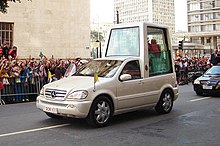
Catholicism[]

Brazil has the largest number of Catholic Christians in the world.[13] Catholicism has been Brazil's main religion since the beginning of the 16th century. It was introduced among the Native Brazilians by Jesuits missionaries and also observed by all the Portuguese first settlers.
During colonial times, there was no freedom of religion. All Portuguese settlers and Brazilians were compulsorily bound to the Catholic faith and were bound to pay tithes to the church. After the Brazilian independence, the first constitution introduced freedom of religion in 1824, but Catholicism was kept as the official religion. The Imperial Government paid a salary to Catholic priest and influenced the appointment of bishops. The political-administrative division of the municipalities accompanied the hierarchical division of the bishoprics in "freguesias" (parishes). There was also some hindrances to the construction of temples and cemeteries that belonged to the Catholic Church. The first Republican Constitution in 1891 separated religion from state and made all religions equal in the Codes of Law, but the Catholic Church remained very influential until the 1970s. For example, due to the strong opposition of the Catholic Church, divorce was not allowed in Brazil until 1977 even if a separated couple observed a different religion.
The Catholic faith practiced in Brazil is full of popular festivities rooted in centuries-old Portuguese traditions, but also heavily influenced by African and Native Brazilian usage. Popular traditions include pilgrimages to the National Shrine of Our Lady of Aparecida (Nossa Senhora Aparecida), the patron saint of Brazil, and religious festivals like the "Círio de Nazaré" in Belém and the "Festa do Divino" in many cities of Central Brazil. Areas that received many European immigrants in the last century, specially Italian and German, have Catholic traditions closer to that practiced in Europe.
The largest proportion of Catholics is concentrated in the Northeast (59%) and South (53%) regions. The smallest proportion of Catholics is found in the Center-West region (49%). The State of Piauí has the largest proportion of Catholics (85%) and the State of Rio de Janeiro has the smallest one (45.19%). Among the state capitals, Teresina has the largest proportion of Catholics in the country (86.010%), followed by Aracaju, Fortaleza, Florianópolis and João Pessoa.[14][15]
Protestantism[]
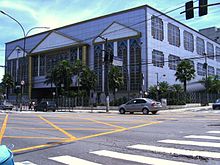
Protestantism in Brazil largely originated with American missionaries in the second half of the 19th century, following up on efforts that began in the 1830s. Evangelical Protestantism and Pentecostalism has grown very rapidly in Brazil since the late 20th century.[16] The 2010 Census reported that 22.2% of the Brazilian population is Protestant, about 44 million people. Brazil has many versions of Protestantism. These include neo-Pentecostals, old Pentecostals and Traditional Protestants (most of them Baptists, Presbyterians and Methodists) predominantly from Minas Gerais to the South. The Anglican Episcopal Church of Brazil, part of the Anglican Communion, has some 120,000 members. Centers of neo-Pentecostalism are Londrina in Paraná state, as well the cities of São Paulo, Rio de Janeiro and Belo Horizonte (capital of Minas Gerais), especially the suburban and nearby areas of these cities. Lutherans are concentrated mostly in the states of Rio Grande do Sul, Santa Catarina and in countryside regions of the states of Rio de Janeiro and Espírito Santo.
As of the year 2000, the largest proportion of Protestants was found in North (19.8%), Central-West (18.9%) and Southeast (17.5%) regions. Among the state capitals, Rio de Janeiro has the largest proportion of non-Pentecostal Protestants in the country (10.07%), followed by Vitória, Porto Velho, Cuiabá and Manaus. But Goiânia is the state capital with the largest proportion of Pentecostal Protestants in the country (20.41%), followed by Boa Vista, Porto Velho, Belém and Belo Horizonte.[17][18]
Orthodoxy[]
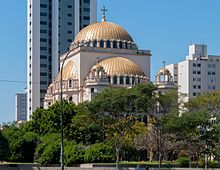
The Eastern Orthodox Church is also present in Brazil. The Orthodox Metropolitan Cathedral, located in São Paulo, is the See of the Archdiocese of the Greek Orthodox Church of Antioch in São Paulo. It is an example of Byzantine architecture that can be appreciated in South America. Its construction, which begun in the 1940s, was inspired by the Basilica of Hagia Sophia of Istanbul and was inaugurated in January 1954. According to IBGE, there were 131 571 Orthodox Christians in Brazil.[1]
Jehovah's Witnesses[]
In 2014 according to the denomination, Brazil had 767 449 Jehovah's Witnesses with 11 562 congregations and a ratio of 1 Witness to 256 residents.[19] However, the 2010 census reported nearly 1.4 million people listed themselves as members .[1]
Latter-day Saints[]
The 2010 national census reported 226,509 people identifying as members of The Church of Jesus Christ of Latter-day Saints;[20] This is very different from the church's reported membership, in 2012, of 1 173 533[21] causing some to question the membership numbers reported by the LDS church.[22]
The church also reports 1940 congregations and 315 family history centers.[21] The LDS Church now also has 6 temples spread out across the nation, in Campinas, Curitiba, Manaus, Porto Alegre, Recife, and São Paulo, with additional temples under construction or announced in Fortaleza, Rio de Janeiro, Belém, Brasília, and Salvador.
Church president Spencer W. Kimball dedicated the São Paulo Brazil Temple on October 30, 1978. On October 4, 2020, President Russell M. Nelson announced that the church would build a second temple in São Paulo.[23]
Non-Christian religions[]
There are small populations of people professing Buddhism (215 000), Judaism (107 000), Islam (35 000), Shinto, Rastafarian and many other religions. They comprise 21st century immigrants from East Asia, the Middle East, or of recent immigrant descent.
African and indigenous religions[]

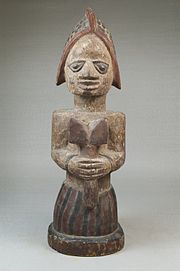
Afro-Brazilian religions are syncretic religions, such as Candomblé, that have many followers, mainly Afro-Brazilians. They are concentrated mainly in large urban centers in the Northeast, such as Salvador, Recife, or Rio de Janeiro in the Southeast. The cities of São Paulo, Porto Alegre and Florianópolis have a great number of followers, but in the South of Brazil the most common African influenced Ritual is Almas e Angola, which is an Umbanda like ritual. Nowadays, there are over 70 "terreiros" (temples) in Florianópolis, which are the places where the rituals run. In addition to Candomblé which is of the Yoruba religion, there is also Umbanda which blends Spiritism by ways of the same Yoruba belief system. There are also Catholics, Protestants and other kinds of Christians who hold a dual belief system and go to both churches and terreiros.
Candomblé, Umbanda, Batuque, Xango, and Tambor de Mina are afro-Brazilian religions influenced by the native cults brought by black slaves shipped from Africa to Brazil. These black slaves would summon their gods, called Orixas, Voduns or Inkices with chants and dances they had brought from Africa. These cults were persecuted throughout most of Brazilian history,[citation needed] largely because they were believed to be pagan or even satanic. However, the Brazilian republican government legalized all of them on the grounds of the necessary separation between the State and the Church in 1889.
In current practice, Umbanda followers leave offerings of food, candles and flowers in public places for the spirits. Candomblé terreiros have similar practices, and there are a number of festivals that occur yearly specially in the Northeast, with celebrations such as the famous Iyemanja Festival and the Waters of Oxala.
From Bahia northwards there are different practices such as Catimbo, Jurema with heavy indigenous elements. All over the country, but mainly in the Amazon rainforest, there are many Indians still practicing their original traditions. Many of their beliefs and use of naturally occurring plant derivatives are incorporated into African, Spiritualists and folk religion.
These religions have suffered increasing hostility from Protestant churches, with attacks on temples and defacement of statues of the gods.[24][25] In recent years measures have been taken to counter religious conflict.[24]
Spiritism[]

Spiritism is a religion, founded in the 19th century by the French educator Allan Kardec, which proposes the study of "the nature, origin, and destiny of spirits, and their relation with the corporeal world".[26] Spiritism follows Jesus's moral teachings, and therefore its status as a non-Christian religion is an object of debate between its followers and mainstream Christians. If considered non-Christian, Spiritism would be by far the largest non-Christian religion in Brazil; if considered as a Christian religion, it would be the third largest denomination after Roman Catholicism and the Protestant Assemblies of God.[citation needed] It studies topics such as life after death, reincarnation, spirits, moral teachings and much more.
Buddhism[]
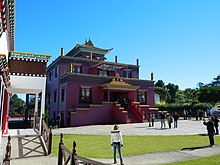
Buddhism is probably the largest of all minority religions, with about 215,000 followers. This is mostly because of the large Japanese Brazilian community.[citation needed] About a fifth of the Japanese Brazilian community are followers of Buddhism. Japanese Buddhist sects like Jodo Shinshu, Nichiren Buddhism (most notably the Soka Gakkai), and Zen are the most popular.[citation needed] Tibetan Buddhism (Vajrayana) is also present, since Chagdud Tulku Rinpoche founded the Khadro Ling center in Três Coroas, Rio Grande do Sul (where he lived until his death in 2002), and many other institutions across the country. However, in recent years both Chinese Mahayana and South East Asian Theraveda sects are gaining popularity. Buddhism was introduced to Brazil in the early twentieth century, by Japanese immigrants, although now, 60% of Japanese Brazilians are now Christian due to missionary activities and intermarriage.[citation needed] Nevertheless, Japanese Brazilian culture has a substantial Buddhist influence.
Judaism[]
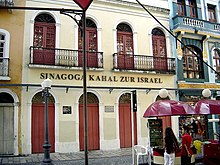
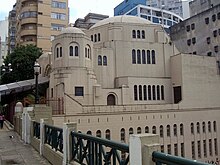
The first Jews arrived in Brazil as cristãos-novos (New Christians) or conversos, names applied to Jews or Muslims who converted to Catholicism, most of them forcibly. According to the Inquisition reports, many New Christians living in Brazil during colonial times were condemned for secretly observing Jewish customs.[27]
In 1630, the Dutch conquered portions of northeast Brazil and permitted the open practice of any religion. Many Jews came from the Netherlands to live in Brazil in the area dominated by the Dutch. Most of them were descendants of the Portuguese Jews who had been expelled from Portugal in 1497. In 1636, the Kahal Zur Israel Synagogue, the first synagogue in the Americas was built in Recife, the capital of Dutch Brazil.[27] The original building remains to this day,[28] but the Jews were forced to leave Brazil when the Portuguese-Brazilians retook the land in 1654.[29]
The first Jews that stayed in Brazil and openly practiced their religion came when the first Brazilian constitution granted freedom of religion in 1824, just after the independence. They were mainly Moroccan Jews.
The first wave of Sephardic Jews was exceeded by the larger wave of immigration by Ashkenazi Jews that came at the end of the 19th and beginning of the 20th centuries, mainly from Russia, Poland, Belarus and Ukraine. A final significant group came, fleeing Nazism or the destruction that followed World War II.
Brazil has the second-largest Jewish population in Latin America of 120 000 people, making up a total of 0.06% of Brazil's population.[30] As of 2017, Rio de Janeiro's Jewish population was 22 000, with 24 active synagogues and São Paulo has a Jewish population of 44,000.[30]

Islam[]
By Pew in 2010, there are 204,000 Muslims in Brazil, representing 0.1% of total population.[31] The Federation of Muslim Associations of Brazil estimates there are about 1.5 million Muslims and others say about 400,000 to 500,000. There are over 150 mosques where Muslims perform their daily prayers.
Islam in Brazil may be presumed to have first been practiced by African slaves brought from West Africa. Scholars note that Brazil received more enslaved Muslims than anywhere else in the Americas.[32] During Ramadan, in January 1835, a small group of black slaves and freedmen from Salvador da Bahia, inspired by Muslim teachers, rose up against the government in the Malê Revolt, the largest slave rebellion in Brazil. (Muslims were called malê in Bahia at this time, from Yoruba imale that designated a Yoruba Muslim.) Fearing the example might be followed, the Brazilian authorities began to watch the malês very carefully and in subsequent years intensive efforts were made towards conversions to Catholic Christianity and erase the popular memory of and affection towards Islam.[33] However, the African Muslim community was not erased overnight, and as late as 1910 it is estimated there were still some 100 000 African Muslims living in Brazil.[34]
A recent trend has been the increase in conversions to Islam among non-Arab citizens.[35]
Hinduism[]
Most of the Brazilian Hindus are ethnic East Indians. However, there are new converts due to the missionary effects of Hare Krishnas.
There are 1500 PIOs (People of Indian origin) and about 400 NRIs (Non-Resident Indian) in Brazil.
- First wave of Immigration
A small number of Sindhis had arrived here from Suriname and Central America in 1960 to set up shop as traders in the city of Manaus.
- Second wave of Immigration
It consisted of university professors who arrived in the 1900s and also in the 1970s.
Other PIOs migrated to this country from various African countries, mainly from former Portuguese colonies (especially Mozambique), soon after their independence in the 1970s. The number of PIOs in Brazil has been augmented in recent years by the arrival of nuclear scientists and computer professionals.
There are as many as 1500 PIOs among the Indian community in Brazil, and only 400 NRIs since foreign nationals can acquire local citizenship without any discrimination after 15 years of domicile in this country. Brazil has also no bar against dual citizenship. But in recent years, it has been granting immigration visas only in high technology fields. The only exceptions are the Sindhis in Manaus (who have formed an Indian Association with about a hundred members) and the Goans in São Paulo.
Beside the PIOs, there are Hindu organizations such as ISKCON, Brahma Kumaris are very active in Brasil. The number of adherents of these organizations is not officially recorded but is estimated to be a few thousand. The Vedic Astrology, vedanga of hinduism, is increasingly popular in Brazil, specially by the efforts of the Academia Brasileira de Astrologia Védica (ABAV), that promotes this branch of the Vedic culture in the country.
Positivist Church of Brazil[]
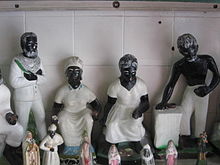
Many confuse Spiritism with Afro-Brazilian Religions like Umbanda, Candomblé and others that have a following of almost 600 000 adherents. One of the most unusual features of the rich Brazilian spiritual landscape are the sects which use ayahuasca (an Amazonian entheogenic tea), including Santo Daime, União do Vegetal, and Centro de Cultura Cósmica. This syncretism, coupled with ideas prevalent during the military dictatorship, has resulted in a church for the secular, based on philosopher Auguste Comte's principles of positivism, based at the Positivist Church of Brazil in Rio de Janeiro.
Baháʼí Faith[]
The Baháʼí Faith in Brazil started in 1919 with Baháʼís first visiting the country that year,[36] and the first Baháʼí Local Spiritual Assembly in Brazil was established in 1928. There followed a period of growth with the arrival of coordinated pioneers from the United States finding national Brazilian converts and in 1961 an independent national Baháʼí community was formed. During the 1992 Earth Summit, which was held in Brazil, the international and local Baháʼí community were given the responsibility for organizing a series of different programs, and since then the involvements of the Baháʼí community in the country have continued to multiply. The Association of Religion Data Archives (relying on World Christian Encyclopedia) estimated some 42,100 Baháʼís in Brazil in 2010.[37]
Japanese New Religions[]
There are, in Brazil, many followers of Japanese new Religions like Oomoto , PL Kyodan, Seicho-no-Ie and the Church of World Messianity. The number of these religions, if merged, may be in the house of Hundred of Thousands.
L
Beliefs[]
A 2007 poll, made by Datafolha and published in newspaper Folha de S. Paulo, asked diverse questions about the beliefs of the Brazilian people. In this poll, 64% reported to be Catholics, 17% Pentecostal Protestants, 5% non-Pentecostal Protestants, 3% Kardecists or Spiritists, 3% followers of other religions, 7% non-religious or atheists. Less than 1% reported to follow Afro-Brazilian religions.[38][39][40]
- Belief in God and the Devil
- 97% of Brazilians reported to believe in God; 2% have doubts and 1% do not believe in God.
- 75% reported to believe in the Devil, 9% have doubts and 15% do not believe in the Devil.
- 81% of those non-religious reported to believe in God.
- About Jesus Christ
- 93% Reported they believe Jesus Christ rose after death; 92% that the Holy Spirit exists; 87% in the occurrence of miracles; 86% that Mary gave birth to Jesus as a virgin; 77% that Jesus will return to Earth at the end of time; 65% that the sacramental bread is the body of Jesus; 64% that after death some people go to Heaven; 58% that after death some people go to Hell and 60% that there is life after death.
- Belief in saints
- 57% Believe there are saints.
- 49% Pray for the intercession of a saint (68% among self-declared Catholics).
- 18% Pray for the intercession of Our Lady of Aparecida (26% among Catholics); Saint Anthony, Saint Expeditus (5% each), Saint George (3%), Saint Jude, Saint Francis of Assisi and Saint Joseph (2% each).
- About the Catholic priests
- 51% Believe some priests respect chastity, 31% most, 8% none and 4% they all do.
- 66% That priests should be allowed to marry (59% among Catholics and 94% among followers of Candomblé).
- About the sexual abuse scandals involving priests, 38% believe some of the complaints are true, 30% most are, 21% all are and 4% none of them.
- About different religions
- About the sentence "Catholics do not practice their religion", 19% reported to agree completely and 41% agreed, but not completely.
- About the sentence "the Protestants are misled by their priests", 61% agreed (77% among the Kardecists, 67% among Catholics and 45% among Protestants).
- About the sentence "Umbanda is a Devil thing", 57% agreed (83% among Evangelical Protestants, 53% among Catholics and 12% among Umbandists).
- About the sentence "Jews only think about money", 49% agreed. 51% disagreed.
- About the sentence "Muslims advocate terrorism", 49% agreed. 51% disagreed.
Regional data[]
| Region | Catholic (%) | Protestant (%) | Spiritism (%) | Afro-Brazilian religion (%) | Other (%) | Irreligion (%) | Asian religions (%) |
|---|---|---|---|---|---|---|---|
| 85.1 | 9.7 | 0.3 | 0.1 | 1.4 | 3.4 | 0.0 | |
| 79.2 | 9.9 | 0.5 | 0.1 | 6.5 | 4.7 | 0.1 | |
| 78.8 | 14.6 | 0.6 | 0.0 | 1.8 | 4.0 | 0.2 | |
| 77.0 | 15.1 | 0.6 | 0.1 | 1.4 | 5.7 | 0.1 | |
| 76.4 | 11.8 | 1.1 | 0.2 | 1.9 | 8.1 | 0.5 | |
| 76.0 | 15.4 | 0.8 | 0.0 | 1.4 | 10.4 | 0.0 | |
| 74.5 | 17.2 | 0.2 | 0.0 | 1.5 | 6.3 | 0.3 | |
| 73.1 | 20.0 | 1.2 | 0.2 | 1.8 | 3.3 | 0.4 | |
| 70.4 | 20.2 | 2.1 | 0.0 | 2.3 | 3.9 | 1.1 | |
| 68.8 | 18.3 | 3.2 | 1.5 | 2.3 | 5.3 | 0.6 | |
| 68.3 | 23.0 | 0.2 | 0.0 | 2.2 | 5.9 | 0.4 | |
| 67.7 | 22.2 | 1.0 | 0.0 | 2.6 | 4.6 | 2.9 | |
| 65.9 | 20.3 | 1.4 | 0.1 | 1.8 | 10.4 | 1.7 | |
| 65.2 | 17.4 | 1.1 | 0.3 | 4.0 | 12.0 | 0.0 | |
| 64.6 | 22.2 | 2.0 | 0.1 | 3.1 | 8.0 | 2.2 | |
| 63.7 | 25.8 | 0.4 | 0.1 | 2.1 | 7.0 | 0.9 | |
| 63.5 | 28.0 | 0.4 | 0.0 | 2.3 | 5.5 | 0.3 | |
| 63.4 | 24.5 | 1.3 | 0.1 | 3.0 | 6.6 | 1.1 | |
| 60.1 | 24.1 | 3.3 | 0.3 | 4.1 | 5.1 | 3.0 | |
| 58.8 | 28.1 | 2.5 | 0.0 | 2.5 | 8.1 | 0.0 | |
| 58.3 | 31.2 | 0.4 | 0.0 | 2.9 | 6.0 | 1.2 | |
| 57.4 | 26.5 | 1.9 | 0.0 | 3.0 | 9.2 | 2.0 | |
| 56.6 | 25.8 | 3.5 | 0.2 | 3.7 | 9.2 | 1.0 | |
| 52.2 | 33.1 | 1.0 | 0.2 | 2.0 | 10.4 | 1.1 | |
| 51.9 | 32.7 | 0.6 | 0.0 | 2.9 | 11.8 | 0.1 | |
| 47.9 | 30.3 | 0.9 | 0.1 | 6.6 | 13.0 | 1.2 | |
| 47.6 | 33.8 | 0.6 | 0.0 | 3.7 | 13.3 | 1.0 | |
| 45.8 | 29.4 | 4.0 | 0.9 | 4.3 | 14.6 | 1.0 |
See also[]
- Demographics of Brazil
- Roman Catholicism in Brazil
- Protestantism in Brazil
- Islam in Brazil
- Judaism in Brazil
- Baháʼí Faith in Brazil
- Hinduism in Brazil
- Religion in Latin America
Pie Chart notes[]
- ^ Does not include the Brazilian Catholic Apostolic Church, which broke away from Rome in 1945.
References[]
- ^ Jump up to: a b c d e IBGE – Instituto Brasileiro de Geografia e Estatística (Brazilian Institute for Geography and Statistics). 2010 Census. Retrieved 7 August 2012.
- ^ "2010 Population Census - General characteristics of population, religion and persons with disabilities (Portuguese)". ibge.gov.br (in Portuguese). 2012-11-16. Archived from the original on 2012-11-16. Retrieved 2019-08-10.CS1 maint: unfit URL (link)
- ^ Facts of Basilica of Aparecida
- ^ Jump up to: a b "Brazil". Berkley Center for Religion, Peace, and World Affairs. Retrieved 2011-12-12.
- ^ Simon Romero, "A Laboratory for Revitalizing Catholicism," New York Times Feb 14, 2013
- ^ "Brazil's Changing Religious Landscape". Pew Research Center. July 18, 2013. Retrieved February 20, 2016.
- ^ "Nordeste e Sul são últimos 'bastiões' católicos do Brasil". G1. June 29, 2013. Retrieved June 3, 2020.
- ^ Carneiro, Nordeste e Sul são últimos 'bastiões' católicos do Brasil (June 29, 2012). "Nordeste e Sul são últimos 'bastiões' católicos do Brasil". BBC Brazil. Retrieved June 3, 2020.
- ^ Michael Astor. Once-Barred Practice Flourishes in Brazil. African-Influenced Candomble Challenged by Pentecostals, Modern Interpretations. The Washington Post, January 1, 2005; Page B07. Accessed: August 8, 2012.
- ^ Decreased the number of Catholic and African religions. Increased the number of Protestants (Census 2000)
- ^ Somer Wiggins. Followers of Brazil’s Umbanda religion worship despite discrimination. July 2, 2012. McClatchy. Accessed August 8, 2012.
- ^ IBOPE - Instituto Brasileiro de Opinião e Estatística. Pesquisa de Opinião Pública sobre Criacionismo. Dec. 2004. Accessed 2008-11-03
- ^ IBGE - Instituto Brasileiro de Geografia e Estatística (Brazilian Institute for Geography and Statistics). 2000 Census. Accessed 2007-04-24
- ^ Folha Online - Mundo. Estagnação econômica explica recuo do catolicismo no Brasil, diz FGV. 2005-04-20
- ^ IBGE - Instituto Brasileiro de Geografia e Estatística (Brazilian Institute for Geography and Statistics). Notícias - Estudo revela 60 anos de transformações sociais no país. Accessed 2008-11-03.
- ^ Patrícia Birman, and Márcia Pereira Leite. "Whatever Happened to What Used to Be the Largest Catholic Country in the World?," Daedalus (2000) 129#2 pp. 271-290 in JSTOR
- ^ Folha de S.Paulo. 64% dos brasileiros se declaram católicos
- ^ G1 - Globo.com. Brasil - Notícias - Em 60 anos, Brasil ficou mais mestiço, evangélico e "casado"
- ^ 2015 Yearbook of Jehovah's Witnesses
- ^ "População residente, por situação do domicílio e sexo, segundo os grupos de religião - Brasil - 2010" (PDF). Instituto Brasileiro de Geografia e Estatística. Retrieved 2013-03-21.
- ^ Jump up to: a b "Brazil - LDS Statistics and Church Facts". The Church of Jesus Christ of Latter-day Saints. Retrieved 2012-09-17.
- ^ Stack, Peggy Fletcher (16 July 2012). "Brazil mystery: Case of the missing Mormons (913,045 of them, to be exact)". Salt Lake City Tribune. Retrieved 3 March 2015.
- ^ 6 new temples announced by President Nelson, including another Utah location
- ^ Jump up to: a b Neo-Pentecostalism and Afro-Brazilian religions: explaining the attacks on symbols of the African religious heritage in contemporary Brazil. Translation from: Mana, Rio de Janeiro, v.13 n.1, p. 207-236, Apr. 2007.
- ^ Dom Phillips. Afro-Brazilian religions struggle against Evangelical hostility. Washington Post, February 6, 2015.
- ^ Moreira-Almeida, Alexander (2008). Allan Kardec and the development of a research program in psychic experiences
- ^ Jump up to: a b Oreck, Alden. The Virtual Jewish History Tour: Brazil. Jewish Virtual Library. Accessed 2008-06-09
- ^ Synagogue in Brazilian town Recife considered oldest in the Americas. Haaretz 2007-11-12. Accessed 2008-06-09
- ^ Friedman, Saul. Jews and the American Slave Trade, p. 60. Transaction Publishers, 1997. ISBN 0-7658-0660-6
- ^ Jump up to: a b "The Jewish Community in Brazil". Beit Hatfutsot. Retrieved 2020-03-12.
- ^ "Table: Muslim Population by Country". Pew Research Center's Religion & Public Life Project. 2011-01-27. Retrieved 2021-07-10.
- ^ Lovejoy, Paul E., Muslim Encounters With Slavery in Brazil, Markus Wiener Pub., 2007. ISBN 1-55876-378-3.
- ^ Joao Jose Reis, Slave Rebellion in Brazil: The Muslim Uprising of 1835 in Bahia, Johns Hopkins University Press, London 1993
- ^ Steven Barboza, American Jihad, 1993
- ^ "Bureau of Democracy, Human Rights, and Labor International Religious Freedom Report 2009" October 26, 2009, US Department of State report on Brazil
- ^ Lamb, Artemus (November 1995). The Beginnings of the Baháʼí Faith in Latin America:Some Remembrances, English Revised and Amplified Edition. 1405 Killarney Drive, West Linn OR, 97068, United States of America: M L VanOrman Enterprises.CS1 maint: location (link)
- ^ "QuickLists: Most Baha'i Nations (2010)". Association of Religion Data Archives. 2010. Retrieved 2020-10-15.
- ^ Data Folha - Opinião Pública. 64% dos brasileiros se declaram católicos 2007-05-05. Accessed 200-11-03
- ^ Renascença Website. Quase todos os brasileiros acreditam em Deus
- ^ 97% dos Brasileiros Dizem Acreditar totalmente na Existência de Deus e 75% Acreditam no Diabo
- ^ «Censo 2010». IBGE
- ^ «Análise dos Resultados/IBGE Censo Demográfico 2010: Características gerais da população, religião e pessoas com deficiência» (PDF)
- Religion in Brazil